Lea Wait's Blog, page 77
November 4, 2022
Weekend Update: November 5-6, 2022
 Next week at Maine Crime Writers there will be posts by Kate Flora (Monday), Jule Selbo (Tuesday), Joe Souza (Thursday), and Vaughn Hardacker (Friday).
Next week at Maine Crime Writers there will be posts by Kate Flora (Monday), Jule Selbo (Tuesday), Joe Souza (Thursday), and Vaughn Hardacker (Friday).
In the news department, here’s what’s happening with some of us who blog regularly at Maine Crime Writers:
An invitation to readers of this blog: Do you have news relating to Maine, Crime, or Writing? We’d love to hear from you. Just comment below to share.
And a reminder: If your library, school, or organization is looking for a speaker, we are often available to talk about the writing process, research, where we get our ideas, and other mysteries of the business, along with the very popular “Making a Mystery” with audience participation, and “Casting Call: How We Staff Our Mysteries.” We also do programs on Zoom. Contact Kate Flora
C’est un petit monde
Ooh la la. I have some good writing news. Yay for more euros! Do you know I have been an international best-selling author? C’est vrai. At least in France. (I am hearing the Coneheads now. At. Least. In. France.) I’m sorry to say it’s not my 1920s-set mystery series that climbed the Amazon.fr charts, but rather the four Edwardian-era Ladies Unlaced romance books. They feature an unusual employment agency and some rather desperate employers, and the first got a starred review from Library Journal which I’m gonna brag on until I’m dead. They sold really well when they were first translated, and the French language rights have just been renewed.
I had to sign an e-document on my computer to extend them. Well, after rolling the mouse around like I was drunk, I managed to cobble together some of the letters in my name. I would have been better off writing a big X for all that you can read it.
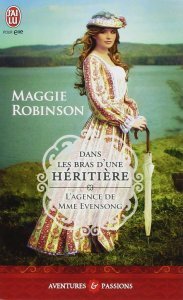
Foreign editions are fascinating. I’ve been translated into nine languages, and depending on the alphabet, can sometimes barely recognize my name. The cover artwork is almost always changed, and often the titles are too. The French editions even changed the name of the series, but kept the first title (In the Arms of the Heiress). The subsequent books are totally different. In the Heart of the Highlander became Give Me One Night, The Reluctant Governess is The Colors of Eliza, and The Unsuitable Secretary morphed into Under the Spell of Harriet. I still can’t read them no matter who casts the spell or what they’re called.
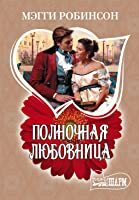
I took two years of French in high school, where my teacher, Madame Rothenberg was young, pretty, and very stylish. She fled from Belgium to Spain to escape the Nazis (if you have time, her oral history is fascinating: The Digital Collections of the National WWII Museum : Oral Histories | Oral History (ww2online.org), and I often wonder how she wound up in a suburban New York classroom.
Alas, as great as a teacher she was, I was absolutely stymied in conversation. I aced memorizing vocabulary lists, but when it was time to talk, nada. I can pick out a few words when I read now, but not enough to make much sense out of them. I was, however, pretty good with menus and street signs when we were in Paris. Le hamburger avec fromage remains a classique.
The first two books in this series were also translated into German, and something amazing happened. Years ago, we hosted an exchange student, multi-lingual Ursula from Kulmbach, Germany, who grew up to own a translation company. Guess who was hired to do the books? Small world indeed! Here In the Heart of the Highlander has turned into A Scandal in Scotland. Gotta love those scandals, LOL.
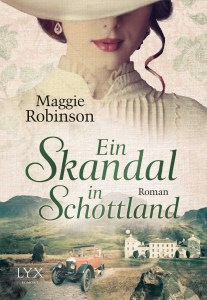
I am reminded of George Clooney, who recently said, “I’m from Kentucky. English is my second language.” Americans are very fortunate that most of the world teaches English in their schools. We seem to be very resistant to learning another language, and so often have trouble with our own. Bless those souls who can move from one culture to another and make themselves understood!
Do you have a passing acquaintance with a foreign language? I need subtitles, even for English programs, LOL.
“Do you know what a foreign accent is? It’s a sign of bravery.” ― Amy Chua
For more info on Maggie and her books, please visit www.maggierobinson.net
November 3, 2022
De Feet or Defeat: Where do you stand?
John Clark with a soap box moment. Douglas Rooks’ opinion piece in today’s Waterville Sentinel begins thusly: “Tuesday will mark the 50th anniversary of my first vote. Since 1972, I’ve voted in 12 presidential elections and 11 previous midterms, and on a lot of other occasions. “
He might as well have been describing me. Like many of my generation, I wasn’t able to vote at a time when my emotions and involvement was at fever pitch in the late 1960s. Once I was able to register, I vowed never to miss a state or national election and I’ve been able to do so.
In the last decade, I’ve gone beyond simply voting, have gone to several state conventions as a delegate, run for the state legislature, and this year, have campaigned on weekends for Democrats in two counties. When asked to do a bit more by the Progressive Turnout Project, I signed on to purchase 100 postcards and stamps. The organization emailed me a list of 100 registered voters in numerous states from Maine to New Mexico. I addressed each card, added a message to encourage them to vote, as well as thanking them for doing so, and mailed them on October 28th. The process, thanks to arthritic hands and nearly illegible penmanship, took the better part of three days. Will it have an impact? I hope so, but actions like the ones I have taken during this election cycle are important, if only to make me feel as though I’ve done the best I can.
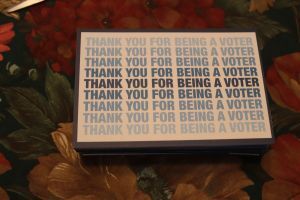
My recent tumble off a stone wall while picking apples that resulted in my landing face first on a tar road, cut short some of what I wanted to do, as well as dope-slapping any remaining feelings of dexterity and ability to do things like I could just a few years ago. I’m sure my emotional state would be worse if I hadn’t gotten involved in the activities described above.
I have one more contribution to democracy this time around. I’m going to a training session this evening so I can be a ballot clerk next Tuesday. God help anyone who tries to harass me on election day.
You have one simple job after reading this-Get off your butt and VOTE. It ain’t rocket science, and I’m not asking/telling you who, or what to vote for. While you’re at it, grab a friend and take them too. If you want to do more, contact the local office of the party of your choice and volunteer to drive folks to the polls. This is just as important in a city as it is in T9, R7.
Think we can’t make a difference? Read this article, then Go vote! https://www.bangordailynews.com/2022/11/02/news/central-maine/pittsfield-library-budget/
October 31, 2022
Mystery Series You May Have Missed
Kaitlyn Dunnett/Kathy Lynn Emerson here, again recommending other people’s books. Today I want to highlight a few mystery series I particularly like. The first three are Indie published by authors who were first published by traditional publishers. In other words, these writers are professionals who know how to do it right.
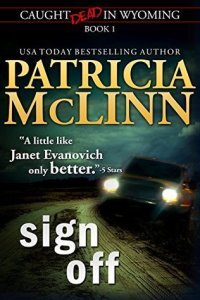 First up is Patricia McLinn’s “Caught Dead in Wyoming” series of eleven books (# 12, Air Ready, is scheduled for April 12, 2023). I was hooked from #1, Sign Off. The amateur sleuth is Elizabeth Danniher, formerly an on-air reporter at a top TV station in a major market, now reduced, through no fault of her own, to working at tiny a station in the middle of nowhere. The balance of personal growth with mystery solving is just about perfect, and the cast of supporting characters adds both complexity and humor to the mix.
First up is Patricia McLinn’s “Caught Dead in Wyoming” series of eleven books (# 12, Air Ready, is scheduled for April 12, 2023). I was hooked from #1, Sign Off. The amateur sleuth is Elizabeth Danniher, formerly an on-air reporter at a top TV station in a major market, now reduced, through no fault of her own, to working at tiny a station in the middle of nowhere. The balance of personal growth with mystery solving is just about perfect, and the cast of supporting characters adds both complexity and humor to the mix.
I met Patricia back in the 1990s when we were both writing category romance. Her day job was working for the Washington Post, a background that serves her well in creating this series. For more information on her books, go to www.PatriciaMcLinn.com.
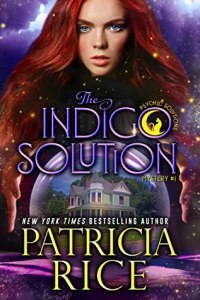 I also met Patricia Rice back in my early writing days. She’s written in a variety of genres, including romance, historical romance, urban fantasy, and mystery. Many of her books feature characters who have inherited a little something extra from their ancestors. In the case of Evie Malcolm Carstairs, amateur sleuth in the “Psychic Solutions” series, it’s the ability to communicate with ghosts. The Indigo Solution, the first book in this five-book series (#5, The Aura Answer, will be released on November 8), introduces her as a “dog walker and ghost buster,” but by the second book, she and some equally interesting continuing characters, some of them with tech and law enforcement experience and some who contribute in non-traditional ways, have formed a company called Sensible Solutions. Their goal is to make a living solving crimes and other problems. There is lots of humor, along with the woo-woo elements, but best of all these books are page turners. You can find out more at www.PatriciaRice.com.
I also met Patricia Rice back in my early writing days. She’s written in a variety of genres, including romance, historical romance, urban fantasy, and mystery. Many of her books feature characters who have inherited a little something extra from their ancestors. In the case of Evie Malcolm Carstairs, amateur sleuth in the “Psychic Solutions” series, it’s the ability to communicate with ghosts. The Indigo Solution, the first book in this five-book series (#5, The Aura Answer, will be released on November 8), introduces her as a “dog walker and ghost buster,” but by the second book, she and some equally interesting continuing characters, some of them with tech and law enforcement experience and some who contribute in non-traditional ways, have formed a company called Sensible Solutions. Their goal is to make a living solving crimes and other problems. There is lots of humor, along with the woo-woo elements, but best of all these books are page turners. You can find out more at www.PatriciaRice.com.
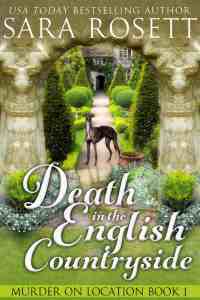 I’ve never met Sara Rosett, but her background is similar to that of the two Patricias. First published by an established New York publisher, she then moved on to become quite prolific as an Indie author. Her “Murder on Location” series falls into the cozy subgenre. Seven books, starting with Murder in the English Countryside, feature amateur sleuth Kate Sharp, an American location scout in England. In the first book, she’s there to scout locations for a new movie version of Pride and Prejudice. Later assignments include scouting locations for filming a documentary about Jane Austen and attending a Regency house party. Each one returns her to England so that other characters who appeared in the first book, including a love interest, can pop up again. A nice sprinkling of humor keeps plots centered around murder from becoming too dark. Sara’s website is www.SaraRosett.com.
I’ve never met Sara Rosett, but her background is similar to that of the two Patricias. First published by an established New York publisher, she then moved on to become quite prolific as an Indie author. Her “Murder on Location” series falls into the cozy subgenre. Seven books, starting with Murder in the English Countryside, feature amateur sleuth Kate Sharp, an American location scout in England. In the first book, she’s there to scout locations for a new movie version of Pride and Prejudice. Later assignments include scouting locations for filming a documentary about Jane Austen and attending a Regency house party. Each one returns her to England so that other characters who appeared in the first book, including a love interest, can pop up again. A nice sprinkling of humor keeps plots centered around murder from becoming too dark. Sara’s website is www.SaraRosett.com.
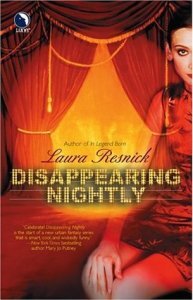
cover of the edition I have–there is a newer one
All three series are great escapist fare. So is a seven-book, humorous, paranormal mystery (aka urban fantasy) series that is traditionally published by DAW Books. The Esther Diamond series by Laura Resnick (yet another acquaintance from the days of writing romance) features a mostly out-of-work actress in New York City who keeps getting involved in solving murders with a occult twist. She’s aided and abetted by a 350 year old sorcerer charged with fighting evil in Manhattan and her on-again, off-again love interest, a police detective. The series starts with Disappearing Nightly and continues with Doppelgangster, Unsympathetic Magic, Vamparazzi, Polterheist, The Misfortune Cookie, and Abracadaver. In case you couldn’t tell from the titles, there’s a strong element of humor in all these books. My personal favorite is Polterheist, in which Esther takes a seasonal job in a department store as Santa’s Jewish elf. Laura’s website is www.LauraResnick.com but she posts more frequently on her Facebook page, where she keeps followers updated on her work fostering cats for a local rescue group and her day job as a walking-tour guide to the “underground” of her home town.
Happy Reading, Everyone!

Kathy Lynn Emerson/Kaitlyn Dunnett has had sixty-four books traditionally published and has self published others, including several children’s books. She won the Agatha Award and was an Anthony and Macavity finalist for best mystery nonfiction of 2008 for How to Write Killer Historical Mysteries and was an Agatha Award finalist in 2015 in the best mystery short story category. She was the Malice Domestic Guest of Honor in 2014. Her most recent publications are The Valentine Veilleux Mysteries (a collection of three short stories and a novella, written as Kaitlyn) and I Kill People for a Living: A Collection of Essays by a Writer of Cozy Mysteries (written as Kathy). She maintains websites at www.KaitlynDunnett.com and www.KathyLynnEmerson.com.
What Scares Us. What Scares You?
From time to time, we offer a group post in which we all weigh in on the same subject. Today, in honor of Halloween, the subject is: What Scares You? We’ll share what scares us, and hope you’ll add some thoughts about what scares you.
Today, in honor of Halloween, the subject is: What Scares You? We’ll share what scares us, and hope you’ll add some thoughts about what scares you.
Kate Flora: As a long-time crime writer who has spent years imagining bad things, as well as a writer of true crime, the thing that I stumble over, and worry about, and definitely fear is randomness. Random crimes. Crimes that aren’t predictable and can’t always be avoided no matter how careful a person is. These are the crimes like the one recently involving a teacher who was out jogging and simply snatched off the street and murdered. The random shooter from a highway bridge or the group of careless teenagers who drop rocks onto passing cars. Yes, huge spiders on my sleeve scare me, as do many of the post-pandemic drivers I encounter on the highway. So do crazies who get in my face when I’m walking (I seem to be a crazy magnet) but most of all, what scares me when I read about them or imagine them are the random acts of violence that can come out of nowhere.
Kaitlyn Dunnett/Kathy Lynn Emerson:  Lots of things in real life scare me right now, including the guy to the left and other far right Maga Republicans who want to take women’s rights back to the dark ages and otherwise screw up this state and this country. Loose-cannon dictators in other countries scare me. And climate change. And natural disasters. And pandemics that kill off way too many friends and acquaintances.
Lots of things in real life scare me right now, including the guy to the left and other far right Maga Republicans who want to take women’s rights back to the dark ages and otherwise screw up this state and this country. Loose-cannon dictators in other countries scare me. And climate change. And natural disasters. And pandemics that kill off way too many friends and acquaintances.
 But in the interest of keeping this post from being too depressing, and in light of the fact that being “scared” can also be a fleeting, almost pleasurable thing, I’ll add that the thing that scared me the most as a kid was the cyclops in The Seventh Voyage of Sinbad. I swear I kept looking over my shoulder, expecting to find it following me, for years after I first saw that movie!
But in the interest of keeping this post from being too depressing, and in light of the fact that being “scared” can also be a fleeting, almost pleasurable thing, I’ll add that the thing that scared me the most as a kid was the cyclops in The Seventh Voyage of Sinbad. I swear I kept looking over my shoulder, expecting to find it following me, for years after I first saw that movie!
Maureen Milliken. What Kathy said! (Full disclosure, I’d thought of saying “the collapse of democracy,” but then I figured I should stay in the spirit of fun, not crushing.soul-shredding terror.)
I don’t really get scared that much, but I have to say any time I’m out walking in the woods by myself, I make sure the panic button app on my phone is engaged. Women should not have to police themselves, or be afraid of hiking or being alone at any time, anywhere, day or night, but yet we’re the ones who have to be on guard.
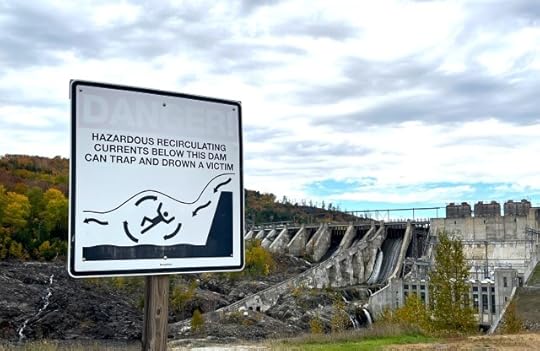
On a recent drive up the Kennebec River Valley, I wasn’t afraid of getting swept away at Wyman Dam, but was fairly nervous about being alone in such a remote place.
And I’m not referring to bears, coyotes, skunks, or any other critters. I’m talking, of course, about the animal that’s most dangerous to women.
A couple weeks ago on a beautiful fall day, I went driving up the upper Kennebec Valley, just to enjoy nature, see the foliage and check things out. At two different Kennebec River boat landings the only people there were me and a guy (different guy each time) sitting in a pickup truck smoking a cigarette. I’m not saying the guy was doing anything wrong, but I’m wary of being alone in a remote area along a river with a guy who is not fishing, not boating (no sign of equipment for those things at least), but just sitting there, watching me get out of my car. Maybe they were enjoying the river and the foliage and all that, too. But since I’m a woman by myself, it’s not in my best interest to find out.
I also checked out the massive and lonely Wyman Dam, but, after walking around a little bit, began to feel like I needed to be back in the safety of my car.
And I knew if something DID happen, people would be all, “What the hell was SHE thinking wandering around on her own like that?”
Several years ago I mentioned to two different men, separately, that I didn’t like to go into the deserted USM library garage late at night. Neither realized my point was that as a woman, I don’t feel comfortable being in dark deserted public places at night. Once I explained it, their lightbulb lit up and they got it. It seemed like a revelation to them. It was funny how I had the exact same experience with each guy. My lightbulb lit up, too — how women have a whole level of fear to deal with that men not only don’t have, but aren’t even aware of.
Laura Richards, formerly of Scotland Yard, and an expert on gender and domestic violence, remarked during a manhunt in England for someone who’d killed a young woman walking home alone at night that, instead of women being urged to stay indoors, maybe the curfew should be for men, since they’re the ones who were doing the attacking. Oh the hue and cry! The horror at the thought that they would have to alter their behavior.
Anyway, none of that’s going to change anytime soon, is it?
 Oh yeah, the other thing? Bats. I used to never have a problem, but a long-running bat infestation in my house, that included frantic indoor visits from the lovable little flying rodents, who weren’t any happier to be in the situation than I was, has caused a bat-phobia. I had it taken care of two years ago (they block the entrances, etc.), but one got in last fall, and now every sound in the eaves makes me lie in bed paralyzed with anxiety that one is going to burst into my bedroom and fly into my face. Very very occasionally, if I hear a noise in the wall, I even go downstairs and sleep on the couch, which bothers the hell out of my cats, because that’s their territory in the wee hours.
Oh yeah, the other thing? Bats. I used to never have a problem, but a long-running bat infestation in my house, that included frantic indoor visits from the lovable little flying rodents, who weren’t any happier to be in the situation than I was, has caused a bat-phobia. I had it taken care of two years ago (they block the entrances, etc.), but one got in last fall, and now every sound in the eaves makes me lie in bed paralyzed with anxiety that one is going to burst into my bedroom and fly into my face. Very very occasionally, if I hear a noise in the wall, I even go downstairs and sleep on the couch, which bothers the hell out of my cats, because that’s their territory in the wee hours.
I’m trying to get over it by reading about bats. The Nature Conservancy is unwittingly helping by frequently sending a fundraising aappeal with a photo of bats on it that says, “Who could love this face?” I feel like it’s a message from the universe for me to get over it and have some kind feelings for the poor bats. I even use the bookmarks that come with it. And, I admit, the return address labels.
Oh, I’m also afraid of a tree failling on my house while I’m sleeping, but that’s a story for another day.
Brenda Buchanan: I’m glad Maureen came out of the closet as a bat weenie, because it gives me courage to admit my fear of mice. They freak me out, full stop. When I was in college in Boston, a dorm across the alleyway from mine was gut renovated. The process loosed many, many, many mice (and rats!) into the neighborhood, all seeking new homes. My dorm apparently had a big neon Welcome Mice! sign invisible to humans, because we had a lot of new dormmates that year. These were not the live-and-let-live field mice of my childhood–not a one resembled Stuart Little–they were urban mice (and rats!) and they stole my sleep often that year.
I don’t have to contend with street smart rodents in my suburban neighborhood in southern Maine, but once burned, twice shy, as they say. Our local expert on how to keep unwanted creatures outside where they belong will be making her biennial visit to our abode soon, sealing up any potential entry points. She is one of my heroes.
Matt Cost: FDR once said, “the only thing we have to fear is fear itself”. Well, yeah. But what are the things that we DO fear? There are many, but I will focus on quitting, which is a fear that haunts me year around, not just at Halloween.
As Lance Armstrong says in the classic movie Dodgeball, “Well, I guess if a person never quit when the going got tough, they wouldn’t have anything to regret for the rest of their life. But good luck to you Peter. I’m sure this decision won’t haunt you forever.”
Kenny Rogers said, “You’ve got to know when to hold ’em, Know when to fold ’em”. And that’s the truth, as long as you realize there are some things you never give up, and you never fold ’em, and you never quit. Regret is not something that goes away.
Maggie Robinson: I too am finding politics pretty problematic, and I can’t tell you how many hours my husband and I have spent discussing the depressing state of almost everything except our adorable grandchildren. But I remind myself to look to the natural world for comfort and joy. Fall is such a special time, and it’s never long enough. I recently went into my beautiful garden to plant 75 daffodil bulbs. After planting about 40 of them, I decided to take a break and bask in the sunshine. Well, guess what else wanted to bask along with me? A really, really enormous slithery snake that slipped through the leaves by my favorite chair, right where my feet would have been if I had sat down. I have been told there are no poisonous snakes in Maine, but that did not stop me from screaming. Then I saw a really, really enormous fat yellow spider weaving a web on that same chair, a few ladybugs already caught in it waiting to become dinner. No basking, but another scream. I went back to planting and dug up a really, really long earthworm. You can figure out what I did–when I went fishing, someone else always had to bait my hook while I closed my eyes. I guess the natural world and I are not truly sympatico. No snakes. No spiders. No worms. And no politicians of a certain persuasion, please.

Sandra Neily: Maureen and Kaitlyn hit the fear truth for me already: a pic of Paul LeRage (yes, that’s what I call him, lerage … am soooooo done with bullies), and then the fear of being a woman alone, exploring, when men feel threatening, even if there’s nothing overt.
But the biggest fear I sometimes had was guiding the Penobscot River and first thing we’d hit was a rapid called Exterminator (named for good flipping reasons), knowing that after a brief, placid warm up, I had a crew who’d never paddled much or at all. Folks figured it out a bit later into the trip, but the first rapid was the unforgiving Exterminator. It was a very bad swim.
And then of course the roar of the river often took away crews’ sense of left from right, as 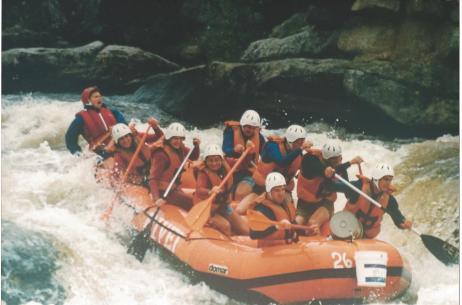 when I’d yell … (the pic shows a good yell) … “All Forward Left,” or “Back Right!” The good news was we were trained on the rough places, trained to work the river as if our entire crew hit the floor and we were left alone up on the raft tube.
when I’d yell … (the pic shows a good yell) … “All Forward Left,” or “Back Right!” The good news was we were trained on the rough places, trained to work the river as if our entire crew hit the floor and we were left alone up on the raft tube.
I now go yearly to stand next to the river’s rapids and cast flies out into the current. And each time I wade out to my knees to fish or just stand there and feel the tug and hear the rush, I am grateful for whatever the river has to offer, but also grateful foryears of being in the thick of it.
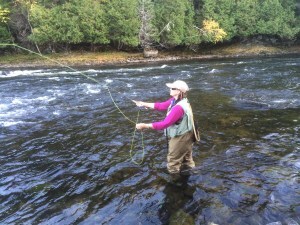
October 28, 2022
Weekend Update: October 29-30, 2022
 Next week at Maine Crime Writers there will be a group post on Monday and posts by Kaitlyn Dunnett/Kathy Lynn Emerson (Tuesday), Kate Flora (Thursday), and Maggie Robinson (Friday).
Next week at Maine Crime Writers there will be a group post on Monday and posts by Kaitlyn Dunnett/Kathy Lynn Emerson (Tuesday), Kate Flora (Thursday), and Maggie Robinson (Friday).
In the news department, here’s what’s happening with some of us who blog regularly at Maine Crime Writers:
Here’s a chance to get a book by Katherine Hall Page, one of our frequent guest authors, for a great price. https://www.amazon.com/dp/B004HD61FE?_bbid=91401177&tag=dealsemailsite-20
Matt Cost will be at the Boston Book Festival on October 29th. He will be at the IPNE table from 11-12 a.m. and the Sisters in Crime table from 1-2 p.m. signing books (along with Kate Flora!)
Matt Cost and Encircle Publications have signed an audible contract with Colin Martin through ACX for the April 2023 release of Velma Gone Awry; A Brooklyn 8 Ballo Mystery.
An invitation to readers of this blog: Do you have news relating to Maine, Crime, or Writing? We’d love to hear from you. Just comment below to share.
And a reminder: If your library, school, or organization is looking for a speaker, we are often available to talk about the writing process, research, where we get our ideas, and other mysteries of the business, along with the very popular “Making a Mystery” with audience participation, and “Casting Call: How We Staff Our Mysteries.” We also do programs on Zoom. Contact Kate Flora
Public Libraries for Everyone? Not So Fast . . .

“Travel New England and you are bound to see Carnegie libraries”
Charlene D’Avanzo: Earlier this week I spoke to a great group of readers at the Baxter Library in Gorham, Maine. My talk – “why a scientist who never wrote a word of fiction became a mystery writer” is one I’ve given many times. Like many writers, I love libraries and am delighted to support them.
U.S. public libraries, which have been around for nearly 200 year, have an interesting history. The first U.S. tax-supported library was in New England – Peterborough New Hampshire – in 1833. Reverend Abiel Abbot proposed that the new library be owned by the people and free to all of the town’s inhabitants. Inspired by Abbot’s idea, in 1849 New Hampshire was the first state to pass a law authorizing towns to raise money to establish and maintain their own libraries.
Philanthropists, especially Andrew Carnegie, helped increase the number of publiclibraries in the late 19th century. Carnegie built over 2000 libraries in the US and many more in the British Commonwealth. By 1919 there were 3,500 in the U.S., nearly half of them known as “Carnegie libraries”. Carnegie believed in giving to the “industrious and ambitious; not those who need everything done for them, but those who, being most anxious and able to help themselves, deserve and will be benefited by the help of others”.
 Travel New England and you are bound to see Carnegie libraries. In Freeport, for example, the previous library is a classic example.
Travel New England and you are bound to see Carnegie libraries. In Freeport, for example, the previous library is a classic example.
I’ve spent pretty much my whole life in New England, where libraries were, I assumed, for everyone, everywhere. Unfortunately, libraries in the south were segregated until very recently.
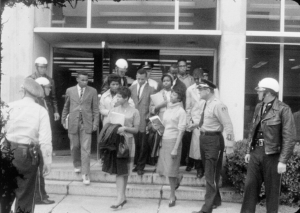 When we think about the civil rights movement many of us picture, I assume, Rosa Parks refusing to give up her seat or Martin Luther King Jr.’s March on Washington. Lesser known is the issue of library segregation, and the great lengths that college-aged students went to in order to integrate them.
When we think about the civil rights movement many of us picture, I assume, Rosa Parks refusing to give up her seat or Martin Luther King Jr.’s March on Washington. Lesser known is the issue of library segregation, and the great lengths that college-aged students went to in order to integrate them.
In his memoirs, Justice Clarence Thomas said he used a black library as a boy. The public library system was finally desegregated by the 1964 Civil Rights Act that outlawed discrimination in public places like public libraries. It is truly a shocking and sad reality that library desegregation took place so recently in our country.
October 27, 2022
To Kill or Not to Kill by Matt Cost
To kill or not to kill. That is the question that we all must ask ourselves at one point or another. Well, at least, if we are mystery writers.
In a cozy mystery, there is usually no killing on the page. A body, delicately placed on a floor is the closest we get to murder. My mysteries (sometimes verging on thrillers) are not cozy. People die on the pages. The Bad and the Good.
So, if you read my books, you know people are going to die. My very first mystery, Mainely Power, starts with the murder of a security guard at a nuclear power plant. This is the type of killing that is easy for the author to get away with as the reader is not invested in this man yet, so the impact is minimal.
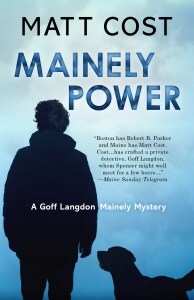
Of course, killing the baddies on the page is almost always acceptable. Whether they be flunkies or kingpins, those readers who don’t possess overly squeamish stomachs, get a thrill out of the villains getting their comeuppance. I have killed many of those over the years and have yet to receive any flak in that regard from readers.
As a matter of fact, I believe that readers probably cheer when the villain of Love in a Time of Hate is revealed and then dispensed. The baddie in this case has few grey areas, even if initially presented as a good person.
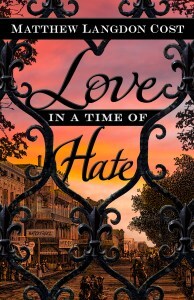
But what of the complicated antagonist who has redeeming features or has been driven to their bad actions by a difficult childhood, trauma in life, or had their faith and trust in the institutions of the world destroyed? These are more difficult to simply kill and often create a sense of unease or even disappointment in the reader.
Even more delicate of a proposition is the killing of a beloved character. This happens in Mainely Power, and I am still accused of being a terrible person for the murder I wrote upon the pages. As a matter of fact, it got me temporarily barred from Facebook, but that’s another story.
I kill one such cherished character in the upcoming December release of Cosmic Trap. I’m not revealing who but be advised. Death will occur, the stakes will be raised, and hopefully, the reader will be rapt within the pages. The same will happen with the next August release of Mainely Wicked.
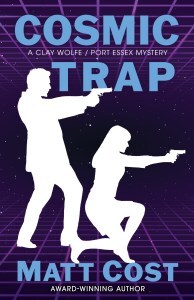
My belief is that if you never kill any of the beloved and main characters, the risk and stakes are lowered, and the reader can coast along knowing that nothing bad as death will happen. This glossed over reality of life and death concerns me for its falseness. We don’t live in a world where only the bad die and the good live. You can only escape into a fictional world as long as that place is believable on some level.
What say you? To kill or not to kill?
About the Author
Matt Cost was a history major at Trinity College. He owned a mystery bookstore, a video store, and a gym, before serving a ten-year sentence as a junior high school teacher. In 2014 he was released and began writing. And that’s what he does. He writes histories and mysteries.
Cost has published four books in the Mainely Mystery series, with the fifth, Mainely Wicked, due out in August of 2023. He has also published three books in the Clay Wolfe/Port Essex series, with the fourth, Cosmic Trap, due out in December of 2022.
For historical novels, Cost has published At Every Hazard and its sequel, Love in a Time of Hate, as well as I am Cuba. In April of 2023, Cost will combine his love of histories and mysteries into a historical PI mystery set in 1923 Brooklyn, Velma Gone Awry.
Cost now lives in Brunswick, Maine, with his wife, Harper. There are four grown children: Brittany, Pearson, Miranda, and Ryan. A chocolate Lab and a basset hound round out the mix. He now spends his days at the computer, writing.
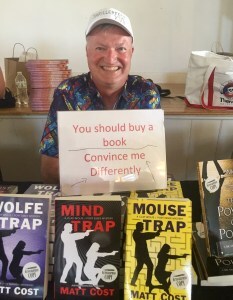
October 24, 2022
Slouching Toward November
Been running around quite a bit this month, promoting the new book. The response to The Last Altruist has been very gratifying, more so than any of the previous books. I’m particularly grateful to Longfellow Books, Sherman’s Maine Coast Books, and the South Portland library for the boosts. And, of course, thank you to everyone who’s read and/or bought The Last Altruist.
It’s a bleary rainy October Tuesday morning on Trout Brook,  which reminds me how close November is. November has always been a mixed blessing for me. We’re more clearly losing the light (commonly rendered as “the days grow shorter,” which isn’t quite accurate). The garden is cleared out, the soil turned. Garlic planted, the dead asparagus fronds cut back and composted. More bulbs and perennials planted against the need for color when we need it the most: come spring.
which reminds me how close November is. November has always been a mixed blessing for me. We’re more clearly losing the light (commonly rendered as “the days grow shorter,” which isn’t quite accurate). The garden is cleared out, the soil turned. Garlic planted, the dead asparagus fronds cut back and composted. More bulbs and perennials planted against the need for color when we need it the most: come spring.
Most of my life I’ve dreaded November, feeling it deeply as the dying of the year. The brown and the gray take over the green, the rain takes over from the sun, the chill buries the memory of warmth. It’s always a temptation in November to indulge the lugubrious side of my nature.
This past year, I added a couple of rocks to that bag. As some of you know, I lost both my parents in quick succession last year at this time, my father on November 7, my mother on December 12. 
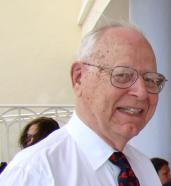 I still think of them every day, of course, and though the loss doesn’t diminish, it becomes more manageable with time. But it darkens November that little bit more.
I still think of them every day, of course, and though the loss doesn’t diminish, it becomes more manageable with time. But it darkens November that little bit more.
I’ve learned to manage my own response to the slow dance of November, though, by not taking on grand new projects, by doing my best to recognize it’s a better time for me to batten down the physical and emotional hatches against the cold dark days and nights ahead. What sustains me, too, in a transition to rest is the love of my remaining family and the care and feeding of, and by, my friends.
We speak knowingly of natural cycles, acknowledge how weather and the natural world undergo periods of activity and contraction, flourishing and rest. We wax on about the gorgeous foliage without remembering that the death of the leaves makes possible the next crop. And we rarely apply our knowledge of nature’s cycles to our own natures.
We push ourselves through our schedules and our disciplines, often without acknowledging our need, like everything else in the world, to rest and regroup. Which is why I’m trying to learn to see November as an opportunity, rather than a time to be gotten through on the way to somewhere else, an opportunity to rest, to be calm.
If you can find it in yourself to breathe, to allow yourself a little rest here and there, I’d recommend it. The work will always be there, as will the responsibilities and the expectations we carry. The road is long. A breathing space will not brighten your month of November, but it could very well ease your heart.
NaNoWriMo Revisited: You Still have Permission to Suck
This post appeared several years ago. As I, and many, many others, are on the cusp of trying again this November, I am reposting it with a few updates. Haven’t tried it yet? Why not this year? It’s fun!
 Kate Flora: Permission to suck? A pretty provocative statement, yes? So I guess I should explain. Yesterday was a cold, rainy, miserable day and I was wrestling with a manuscript that felt like an octopus with a thousand legs. Or arms. Or both. I couldn’t handle it, subdue it, make it behave in any way, and the process was making me grouchy. Then I decided I’d write this blog post, and stared at the blank screen and couldn’t come up with an idea. So I went to my friends on Facebook and asked for help.
Kate Flora: Permission to suck? A pretty provocative statement, yes? So I guess I should explain. Yesterday was a cold, rainy, miserable day and I was wrestling with a manuscript that felt like an octopus with a thousand legs. Or arms. Or both. I couldn’t handle it, subdue it, make it behave in any way, and the process was making me grouchy. Then I decided I’d write this blog post, and stared at the blank screen and couldn’t come up with an idea. So I went to my friends on Facebook and asked for help.
Help they did, of course. I now have enough topics to carry me through to the New Year. And the first one was so absolutely timely that I decided to take it up: Tips for NaNoWriMo.
In case there is a soul somewhere on the planet who doesn’t know, NaNoWriMo stands for National Novel Writers Month. Every November, writers sign up to write a 50,000 word novel during the month. Signing up means you’ll probably be put into a group where you can go to meetings if you want that for support, and you will be able to log in to chart your word counts and your progress, and get encouraging e-mails throughout the month.
The internet is absolutely full of advice about how to prep for NaNoWriMo, how to do  NaNoWriMo. So much advice, in short, that you could probably write a novel using the tips as prompts or just aggregate the advice into a short book. Or is that aggravate? Because with so much advice out there, it can be aggravating. Confusing. Overwhelming. And pretty often, those who are offering the advice are quite certain that they are right.
NaNoWriMo. So much advice, in short, that you could probably write a novel using the tips as prompts or just aggregate the advice into a short book. Or is that aggravate? Because with so much advice out there, it can be aggravating. Confusing. Overwhelming. And pretty often, those who are offering the advice are quite certain that they are right.
Should you outline in advance? Have the plot of the work all sketched out? Perhaps have it all storyboarded and taped to your office wall?
The possibilities are endless. And the bottom line, in my opinion, depends entirely on what kind of a writer you are. Or, if this is an early foray into the world of writing, what kind of person you otherwise are. Do you like to do a lot of prepping or do you like sail into an adventure and wing it and see what life brings?
On your behalf, I went out and waded through a bunch of those advicely blogs. And like a retriever, I have brought back the wisdom that speaks to me. You can snap up my thoughts and make them your own, or go atrolling for yourself.
 So here, in no particular order, are the bits of advice that I think are most useful if you are going to have fun with NaNoWriMo.
So here, in no particular order, are the bits of advice that I think are most useful if you are going to have fun with NaNoWriMo.
Embrace a new mindset.
Answer “YES!”
Just start and keep going.
Silence your editor, that picky little voice that tells you you’re doing it wrong. If necessary, draw a picture of your editor and stick pins in it. Be silly if you need to be. This is your adventure. Own it.
Write fearlessly.
Write “TK” for missing facts. Don’t stop to look things up. Don’t obsess over what you can’t remember. You can fix all that later.
Embrace Anne Lamott’s advice: it’s okay to write a shitty first draft. You can edit a draft and make it better. You can’t edit a blank page.
Embrace the word discipline.
For once, elevate quantity above quality. Don’t edit. Just keep going. Do keep track of your word count. It’s part of the game.
Keep telling yourself: The Perfect is the Enemy of the Good
Remember that you’re not trying to win, you’re trying to be
Don’t let the risk of obsession scare you off
You have permission to suck. Who cares. You may make amazing discoveries in the process.
Unplug. No phone calls. No checking e-mail. No selfies.
Exception: You can make yourself, or your story, a playlist. It can become part of the ritual.
Write in the same place if you can, because the ritual of place can become part of the ritual of writing.
Finally, a bit of heretical advice. The rules say you’re supposed to write something new. But you are writing for you, not for them. If you’ve got the half-finished story in the drawer you’ve never had time to get back to…you are allowed to take it out and finish it. (Don’t tell them I said this.)
November. Your month. You’re the writer. The only thing you have to do is honor your desire to write by giving it the time it deserves. And see where story takes you.
A lot of advice is about prepping…but hey, you’re out of time, and about not bothering agents or editors with your unedited glop at the end. But you wouldn’t do that anyway.
Here are a couple of blogs I used to compile the above. And below, a snippet from a book I wrote during NaNoWriMo one year.
http://terribleminds.com/ramble/2011/10/04/25-things-you-should-know-about-nanowrimo/
Wedding Bell Ruse
Air-horn blaring, the eighteen-wheeler came barreling at her out of the dark. Callie yanked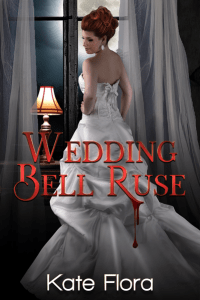 the wheel, adrenaline surging, as she rocked back into her lane. The Jeep fishtailed wildly as she fought for control. Horn still blaring, the truck rushed past and disappeared into the night. Her breath quick and shallow, nerve-trees tingling, she clung to the wheel. Adrenaline carried her on its sharp, acid flow for another mile before it faded, leaving her drained and alone in a night as dark as Galen’s heart. Then, arms trembling, she abandoned her determined press forward, pulled onto the unpaved shoulder and parked, numb from exhaustion. All she could feel was the biting pressure of her nails–hard, sharp slices of sensation–against the palm of her hands. She had no idea where she was or where she was going. Her only plan had been to keep moving, putting time and distance between herself and the mess her life had become.
the wheel, adrenaline surging, as she rocked back into her lane. The Jeep fishtailed wildly as she fought for control. Horn still blaring, the truck rushed past and disappeared into the night. Her breath quick and shallow, nerve-trees tingling, she clung to the wheel. Adrenaline carried her on its sharp, acid flow for another mile before it faded, leaving her drained and alone in a night as dark as Galen’s heart. Then, arms trembling, she abandoned her determined press forward, pulled onto the unpaved shoulder and parked, numb from exhaustion. All she could feel was the biting pressure of her nails–hard, sharp slices of sensation–against the palm of her hands. She had no idea where she was or where she was going. Her only plan had been to keep moving, putting time and distance between herself and the mess her life had become.
How long had she been driving? Ten hours? Twelve? Drive too long without a break and your eyes start playing tricks. You see things that aren’t there, like patches of blood spreading across the road, and you don’t see things that are, like eighteen-wheelers coming at you like Leviathan from the depths. She should get out. Stretch. Walk around in the cold night air and wake herself up. Her body resisted the urging of her brain, stayed inert in the seat.
The night was pure black. No streetlights. No house lights. Wind battered the car, rattling the wipers, panting to get at her as it tore away dried leaves that had sheltered in the depression below the windshield. She watched, eyes at half-mast, as they rustled across the glass like the small animals. It was cold out there. Before she shut off the engine, she’d seen the outside temperature was 38.
She’d left Pennsylvania running on an instinct born of desperation. Get out of town, away from the suspicious looks, the comments, the humiliation. Out of her ransacked apartment and her shredded life. Several hundred miles later, she’d run out of gas—spiritual gas, not petroleum—here on this lonely roadside somewhere in Vermont.
The whole ugly mess had exploded on her a few weeks ago, when she’d woken one morning feeling drugged and groggy, not to her fiancé Galen’s head beside her but to a barren apartment, a stripped office, emptied bank accounts, and note, pinned to his pillowcase by a chip clip that said, “Thanks for everything.” https://www.amazon.com/Wedding-Bell-Ruse-Kate-Flora-ebook/dp/B086K46QHX/ref=sr_1_2?crid=1EBUX2GF5JTN&keywords=wedding+bell+ruse&qid=1666568833&sprefix=wedding+bell+ruse%2Caps%2C114&sr=8-2
You’ve always wanted to write, right? Or you’ve got that half-finished book the drawer that you can’t seem to find the time for? Why not now? True, November is the WORST month for this, but as the cold and dark drive us inside, why not take advantage of that. You’ll be writing about 1700 words a day. It may help to find a writing buddy to keep you on track, and NaNoWriMo can help with that.
Give it a try? What have you got to lose? It may be that the adventure, and the sheer breathless pace will leave you, at the end of the month, excited to keep on writing and finish what you’ve started.
Lea Wait's Blog
- Lea Wait's profile
- 509 followers



